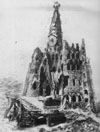 |
 |
 |
 |
 |
 |
 |
 |
 |
|
|
||||||||
 Main south facade, Gaudí original drawing, published in 1910
 Priest, original drawing of Gaudí
 Actual view
 Crypt vaults
JOIN OUR CLUB!!! Register here as a new member if you want to be advised by e-mail on new updates, and take yourFREE WELCOME GIFTS. |
In building the crypt, measurements were taken directly from the multi-cord model and passed on to the land. The outline of the crypt is about 36.5 x 27 meters, and is reminiscent of a tortoise shell with star-like edges. This star shape is due to the inclination of the outer walls, which form regular surfaces, in this case hyperbolic paraboloids. The windows, which allow natural illumination of the crypt, have a perceptible hyperbolic shape, for Gaudí considered the hyperbole the shape which best received and distributed sunlight. In this church, Gaudí, enjoying total freedom in the design, confirmed the validity of the theories that would in the end define his own style. Here, we find construction systems that he later applied to his greatest work, the Sagrada Familia. They include, for example, the inclined columns of the crypt and entry portico. These columns are made of basalt, brought from Castellfollit de la Roca, where they were cut according to the dimensions that Gaudí requested. A founded lead joint was placed between the base, shaft, and capital of these building elements, allowing perfect connections between the pieces, and permitting possible movements of the structure. When one enters the crypt, the four inclined basalt columns stand out, giving the sensation of an organic and natural structure, like the trees in a forest. The crypt has three altars designed by Jujol, two of which are dedicated to the Virgin of Montserrat, patroness of Catalonia, and the Sacred Family. The altar which now presides over the crypt was completed in 1965 by Peter Hardn. The crypt is covered by a tiled vault, over ribs of fifteen-centimeter thick bricks. Two keystones, joined by a robust arch, form the central part of the crypt above the main altar. This ceiling looks like the skeleton of a giant snake that twists over the entire crypt. This crypt is considered one of Gaudí's masterpieces, along with the Sagrada Familia. Here there is an infinite number of details to catch our attention. For example, there are the holy water fonts, made with large seashells held in place by forged iron, or the benches designed by Gaudí, which are apparently designed so that whomever sits there cannot speak with the person beside him, since they are practically seated back-to-back. There was also an interesting circumstance in the construction of the outside stairway, which was to lead to the upper part of the church. In its path, the workers ran into a tree; Gaudí ordered the stairway be detoured a little in order to avoid chopping down the tree. Gaudí said that he could build a stairway in three weeks, but nature would take twenty years to replace that tree.
The Crypt can currently be visited at times that do not coincide with mass, by making a small donation. Inside, one can see some original photographs of the multi-cord model, and other documents related to the construction that were saved.
|